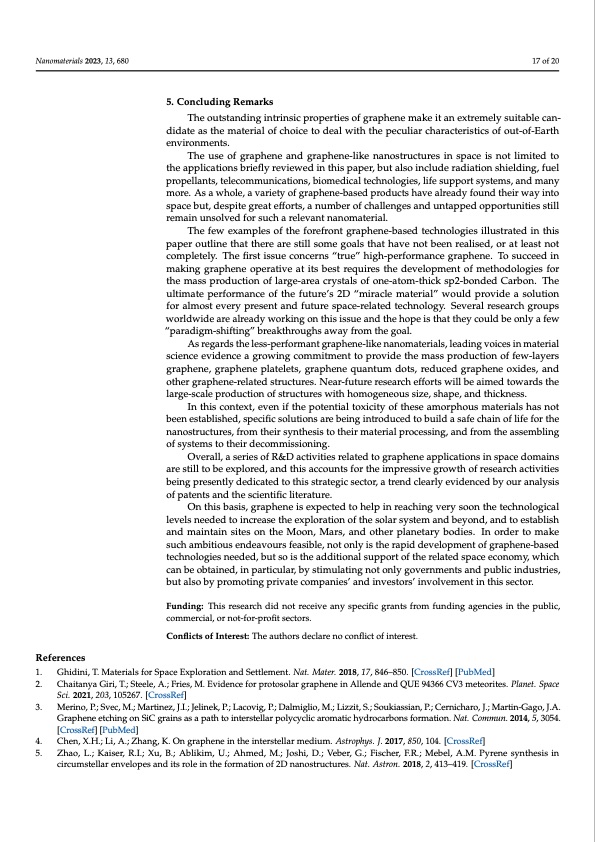PDF Publication Title:
Text from PDF Page: 017
Nanomaterials 2023, 13, 680 17 of 20 References 5. Concluding Remarks The outstanding intrinsic properties of graphene make it an extremely suitable can- didate as the material of choice to deal with the peculiar characteristics of out-of-Earth environments. The use of graphene and graphene-like nanostructures in space is not limited to the applications briefly reviewed in this paper, but also include radiation shielding, fuel propellants, telecommunications, biomedical technologies, life support systems, and many more. As a whole, a variety of graphene-based products have already found their way into space but, despite great efforts, a number of challenges and untapped opportunities still remain unsolved for such a relevant nanomaterial. The few examples of the forefront graphene-based technologies illustrated in this paper outline that there are still some goals that have not been realised, or at least not completely. The first issue concerns “true” high-performance graphene. To succeed in making graphene operative at its best requires the development of methodologies for the mass production of large-area crystals of one-atom-thick sp2-bonded Carbon. The ultimate performance of the future’s 2D “miracle material” would provide a solution for almost every present and future space-related technology. Several research groups worldwide are already working on this issue and the hope is that they could be only a few “paradigm-shifting” breakthroughs away from the goal. As regards the less-performant graphene-like nanomaterials, leading voices in material science evidence a growing commitment to provide the mass production of few-layers graphene, graphene platelets, graphene quantum dots, reduced graphene oxides, and other graphene-related structures. Near-future research efforts will be aimed towards the large-scale production of structures with homogeneous size, shape, and thickness. In this context, even if the potential toxicity of these amorphous materials has not been established, specific solutions are being introduced to build a safe chain of life for the nanostructures, from their synthesis to their material processing, and from the assembling of systems to their decommissioning. Overall, a series of R&D activities related to graphene applications in space domains are still to be explored, and this accounts for the impressive growth of research activities being presently dedicated to this strategic sector, a trend clearly evidenced by our analysis of patents and the scientific literature. On this basis, graphene is expected to help in reaching very soon the technological levels needed to increase the exploration of the solar system and beyond, and to establish and maintain sites on the Moon, Mars, and other planetary bodies. In order to make such ambitious endeavours feasible, not only is the rapid development of graphene-based technologies needed, but so is the additional support of the related space economy, which can be obtained, in particular, by stimulating not only governments and public industries, but also by promoting private companies’ and investors’ involvement in this sector. Funding: This research did not receive any specific grants from funding agencies in the public, commercial, or not-for-profit sectors. Conflicts of Interest: The authors declare no conflict of interest. 1. Ghidini, T. Materials for Space Exploration and Settlement. Nat. Mater. 2018, 17, 846–850. [CrossRef] [PubMed] 2. Chaitanya Giri, T.; Steele, A.; Fries, M. Evidence for protosolar graphene in Allende and QUE 94366 CV3 meteorites. Planet. Space Sci. 2021, 203, 105267. [CrossRef] 3. Merino, P.; Svec, M.; Martinez, J.I.; Jelinek, P.; Lacovig, P.; Dalmiglio, M.; Lizzit, S.; Soukiassian, P.; Cernicharo, J.; Martin-Gago, J.A. Graphene etching on SiC grains as a path to interstellar polycyclic aromatic hydrocarbons formation. Nat. Commun. 2014, 5, 3054. [CrossRef] [PubMed] 4. Chen, X.H.; Li, A.; Zhang, K. On graphene in the interstellar medium. Astrophys. J. 2017, 850, 104. [CrossRef] 5. Zhao, L.; Kaiser, R.I.; Xu, B.; Ablikim, U.; Ahmed, M.; Joshi, D.; Veber, G.; Fischer, F.R.; Mebel, A.M. Pyrene synthesis in circumstellar envelopes and its role in the formation of 2D nanostructures. Nat. Astron. 2018, 2, 413–419. [CrossRef]PDF Image | Role of Graphene in Space Technology

PDF Search Title:
Role of Graphene in Space TechnologyOriginal File Name Searched:
nanomaterials-13-00680-v2.pdfDIY PDF Search: Google It | Yahoo | Bing
Salgenx Redox Flow Battery Technology: Power up your energy storage game with Salgenx Salt Water Battery. With its advanced technology, the flow battery provides reliable, scalable, and sustainable energy storage for utility-scale projects. Upgrade to a Salgenx flow battery today and take control of your energy future.
CONTACT TEL: 608-238-6001 Email: greg@infinityturbine.com (Standard Web Page)